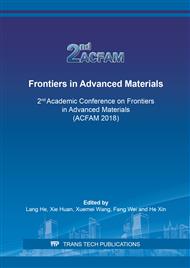[1]
Li Y, Bin X, Zhang Q, et al. Present situation and the countermeasure analysis of bamboo timber processing industry in China[J]. Journal of Forestry Engineering, (2016).
Google Scholar
[2]
Huang Y, Fei B, Wei P, et al. Mechanical properties of bamboo fiber cell walls during the culm development by nanoindentation[J]. Industrial Crops & Products, 2016, 92:102-108.
DOI: 10.1016/j.indcrop.2016.07.037
Google Scholar
[3]
Gurunathan T, Mohanty S, Nayak S K. A review of the recent developments in biocomposites based on natural fibres and their application perspectives[J]. Composites Part A, 2015, 77:1-25.
DOI: 10.1016/j.compositesa.2015.06.007
Google Scholar
[4]
Arrieta M P, Peponi L, López D, et al. Recovery of yerba mate (Ilex paraguariensis) residue for the development of PLA-based bionanocomposite films[J]. Industrial Crops & Products, 2018, 111.
DOI: 10.1016/j.indcrop.2017.10.042
Google Scholar
[5]
Balart J F, Fombuena V, Fenollar O, et al. Processing and characterization of high environmental efficiency composites based on PLA and hazelnut shell flour (HSF) with biobased plasticizers derived from epoxidized linseed oil (ELO)[J]. Composites Part B, 2016, 86:168-177.
DOI: 10.1016/j.compositesb.2015.09.063
Google Scholar
[6]
Çağlar Meriçer, Minelli M, Angelis M G D, et al. Atmospheric plasma assisted PLA/microfibrillated cellulose (MFC) multilayer biocomposite for sustainable barrier application[J]. Industrial Crops & Products, 2016, 93:235-243.
DOI: 10.1016/j.indcrop.2016.03.020
Google Scholar
[7]
Dai X, Xiong Z, Na H, et al. How does epoxidized soybean oil improve the toughness of microcrystalline cellulose filled polylactide acid composites?[J]. Composites Science & Technology, 2014, 90(2):9-15.
DOI: 10.1016/j.compscitech.2013.10.009
Google Scholar
[8]
Rytlewski P, Stepczyńska M, Gohs U, et al. Flax fibres reinforced polylactide modified by ionizing radiation[J]. Industrial Crops & Products, 2018, 112:716–723.
DOI: 10.1016/j.indcrop.2018.01.004
Google Scholar
[9]
Khan B A, Chevali V S, Na H, et al. Processing and properties of antibacterial silver nanoparticle-loaded hemp hurd/poly(lactic acid) biocomposites[J]. Composites Part B: Engineering, 2016, 100:10-18.
DOI: 10.1016/j.compositesb.2016.06.022
Google Scholar
[10]
Ruggiero A, Valášek P, Müller M. Exploitation of waste date seeds of Phoenix dactylifera in form of polymeric particle biocomposite: Investigation on adhesion, cohesion and wear[J]. Composites Part B, 2016, 104:9-16.
DOI: 10.1016/j.compositesb.2016.08.014
Google Scholar
[11]
Kumar N, Das D. Fibrous biocomposites from nettle ( Girardinia diversifolia ) and poly(lactic acid) fibers for automotive dashboard panel application[J]. Composites Part B: Engineering, 2017, 130: 54-63.
DOI: 10.1016/j.compositesb.2017.07.059
Google Scholar
[12]
Scaffaro R, Botta L, Lopresti F, et al. Polysaccharide nanocrystals as fillers for PLA based nanocomposites[J]. Cellulose, 2017, 24(2):447-478.
DOI: 10.1007/s10570-016-1143-3
Google Scholar
[13]
Priya B, Singha A S, Pathania D. Synthesis and kinetics of ascorbic acid initiated graft copolymerized delignified cellulosic fiber[J]. Polymer Engineering & Science, 2014, 55(2):474-484.
DOI: 10.1002/pen.23918
Google Scholar
[14]
Bledzki A K, Gassan J. Composites reinforced with cellulose based fibres[J]. Progress in Polymer Science, 1999, 24(2):221-274.
DOI: 10.1016/s0079-6700(98)00018-5
Google Scholar
[15]
Yingfeng Zuo Wenhao Li. Yiqiang Wu Preparation and characterization of polylactic acid-g-bamboo fiber based on in-situ solid phase polymerization [J]. Industrial Crops & Products 123 (2018) 646–653.
DOI: 10.1016/j.indcrop.2018.07.024
Google Scholar
[16]
Zuo Yingfeng, Li Wenhao, Li Ping, et al. Plasticization of bamboo fiber/polylactic acid degradable composite[J]. China Forestry Science and Technology, 2018, 3(1): 77-82.
Google Scholar
[17]
Yang L, Zuo Y, Gu J, et al. Effect of Different Compatibilizers on Properties of Wood Flour/Polylactic Acid Composite[J]. Polymer Materials Science & Engineering, 2014, 30(8):91-95 and 103.
Google Scholar
[18]
Zuo Ying, Gu Jiyou, Yang Long, et al. Effect of glycerol content on the properties of starch/polylactic acid composite[J]. Journal of Functional Materials, 2014, 45(5): 5087-5091.
Google Scholar
[19]
Zeng J B, Jiao L, Li Y D, et al. Bio-based blends of starch and poly(butylene succinate) with improved miscibility, mechanical properties, and reduced water absorption[J]. Carbohydrate Polymers, 2011, 83(2):762-768.
DOI: 10.1016/j.carbpol.2010.08.051
Google Scholar
[20]
Zuo Yingfeng. Study on compatibility and properties of dry esterified starch/polylactic acid composites [D]. Northeast Forestry University, (2014).
Google Scholar


